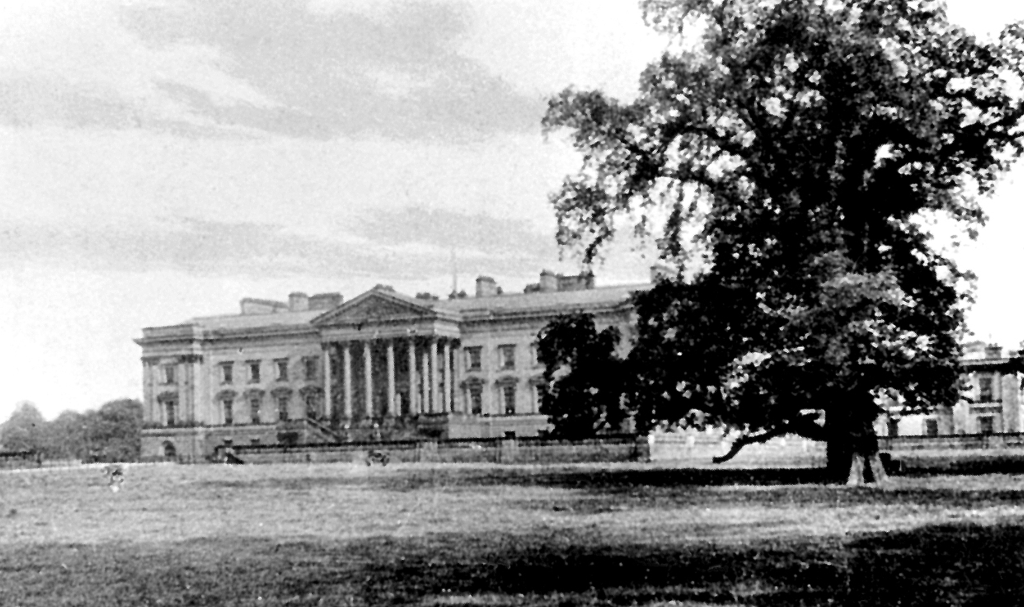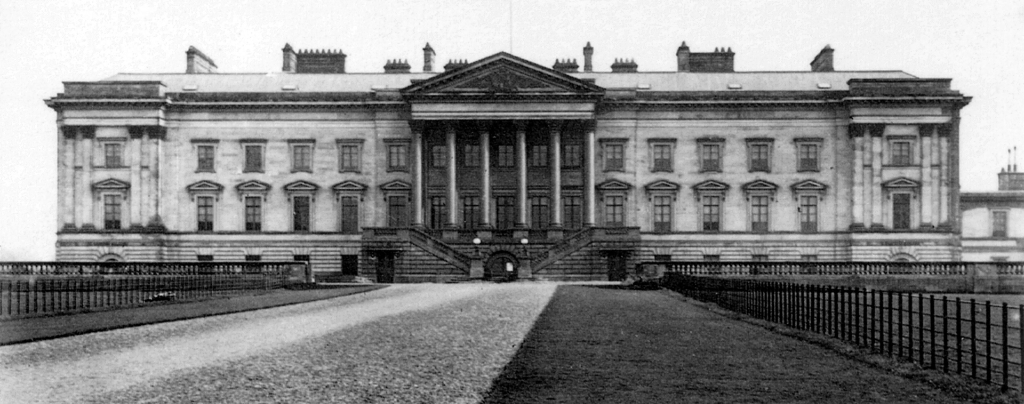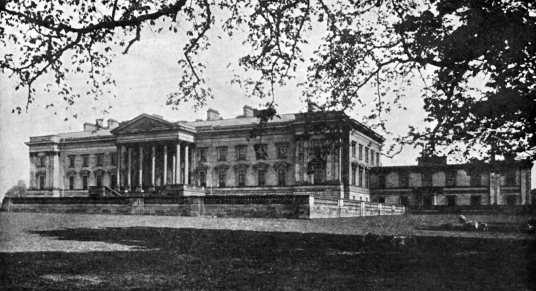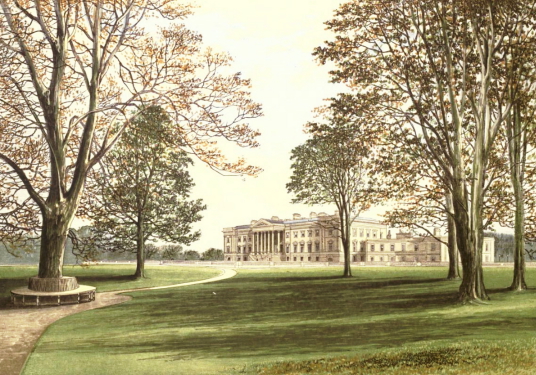Hamilton Palace
Lanarkshire & Glasgow: To east of Hamilton, on minor roads east of A72, Hamilton Low Parks, 300 yards south of Mausoleum.
Ruin or site NS 726560 OS: 64 ML3 6BY
OPEN: Site in Strathclyde Country Park. The HES website hosts a Virtual Reconstruction of the palace: hamilton.rcahms.gov.uk/rediscover.html
Site of castle, which was almost entirely rebuilt at the beginning of the 18th century, and then again in 1822 to form a magnificent and massive classical mansion of two storeys over a raised basement. Two large wings running at right angles to the main block were of three storeys, and the main front had a grand entrance with an impressive columned porch. The whole building was demolished in 1927 because of mining subsidence, but the walls of the castle were found to be as much as 10 foot thick. Much of the furniture, paintings and porcelain from here are now on display at Lennoxlove.
‘Hamelton’ is very prominently marked on Pont’s map of Lanark, and is shown as a large building of three storeys with higher corner towers. The place is also on Blaeu.
The castle, first mentioned in 1455, was a property of the Hamiltons, and also known as The Orchard, who also had a stronghold at Cadzow.
Mary, Queen of Scots, visited in the summer of 1563. The castle was burned down, probably by the forces of the Regent Morton in 1579, although by 1591 it had been repaired or rebuilt. The building
was then developed down the centuries until little survived of the castle except foundations.
In 1695 William, 3rd Duke of Hamilton, had the architect James Smith build him what was to become one of the grandest mansions in the country. Further work took place for Alexander, 10th Duke, in
the 19th century, most notably with a new facade for the north front by the architect David Hamilton. He used a William Adam design, and this was completed in 1842. The lands around the palace were
purchased and cleared, creating a vast landscaped environment with a grand tree-lined avenue, leading from Chatelherault to the far end of the palace grounds.
During the setting out of Strathclyde Park, within which the palace grounds were incorporated, vaulted cellars were discovered. These were thought to belong to the original house. They were
infilled with rubble.
Clustered around the palace site various other places from the old town are recorded. These include the Bishop’s Gate, tolbooth and the collegiate church. Other places of interest the massive
and elaborate Dukes of Hamilton Mausoleum [NS 723563] and the Mote Hill [NS 727566]. The mausoleum was built by Alexander, 10th Duke of Hamilton, and is a magnificent building, some 120 foot high,
with a prominent dome and oculus, begun in 1840 and finished five years after the Duke’s death. It has bronze doors and a fine interior. The 10th Duke and many of his ancestors were interred here,
but when the building was found to have subsidence and was prone to flooding, his remains and the others were relocated to a cemetery.
It is simply impossible, with the very limited space at my command, to give more than a mere outline of the descent of this illustrious house, and a most brief description of their splendid seat, the embarras de richesse in each case being so great.
As to the place, the park, which is of great extent, and the scenery of the most diversified beauty, is bounded on one side by a full sweep of the broad and majestic Clyde, and on another, at a distance of two miles, the river Evan runs between two lofty and precipitous banks, the one crowned by the Chateau of Chatelherault, and the other by the Castle of Cadzow, itself romantically situated on a high and steep rock overlooking the grand old forest of the same name.
Hamilton Palace is one of the most noble residences in Europe, and its collection of precious works of art and valuable curiosities far surpasses those of Chatsworth, or of Stowe as it was. In fact the whole place is all but of regal magnificence, and a mere catalogue of the contents of the house would fill a volume.
There is a splendid suite of royal rooms intended for the reception of persons of the most exalted ranks. The ancient gallery has its walls filled with a grand series of family portraits, from the Regent Duke of Chatelherault downwards, and these, as may be supposed, by many of the great artists, such as Cornelius Jansen, Vandyke, Mytens, Kneller, Lely, Reynolds, and others. It leads into another ancient suite of state apartments, adorned with many of the masterpieces of the Italian school of painting, namely, Bassano, Leonardo da Vinci, Guido, Guercino, Sassoferato, Pietro da Cortona, Titian, Bronzino, Luca Signorelli, Antonello da Messina, Sandro Botticelli, and Claude, besides others of the Spanish and Flemish schools.
Besides these are costly cabinets of ebony and other rare materials; oriental and ancient manuscripts; rare editions of the classic authors; etc., etc., etc.
From: A Series of Picturesque Views of Seats of the Noblemen and Gentlemen of Great Britain and Ireland, Volume VI (by F. O. Morris, 1880s)
Description of the palace and its decoration and furnishings from 1878:
HAMILTON PALACE.
The Palace of Hamilton was originally a square tower about 20 feet long and 16 feet wide. The old part of the house as it now stands was erected about 1591, and about 1717 it was almost entirely rebuilt. The front, facing the south, was ornamented with pillars of the Corinthian order, and two deep wings were added, in the form of a Roman H, much in the style of Greenwich Hospital. In 1822 additions on an extensive scale were carried to completion by Alexander, tenth Duke (the present Duke's grand- father), with Mr Hamilton, as architect, and Mr Connell (builder of Burns' Monument at Ayr) as builder, which have rendered the Palace of Hamilton one of the largest and most magnificent structures of the kind in Britain. The modern part consists of a new front facing the north, 264 feet 8 inches in length, and three stories high, with an additional wins; to the west, 100 feet in length, for servants' apartments. A new corridor is carried along the back of the old building, containing baths, &c. The front is adorned by a noble portico, consisting of a double row of Corinthian columns, each of one solid stone surmounted by a lofty pediment. The shaft of each column is upwards of 25 feet in height and about 3 feet 3 inches in diameter. These were each brought in the block from a quarry in Dalserf, about eight miles distant, on an immense waggon constructed for the purpose and drawn by thirty horses. The Palace stands close upon the town, on the upper border of the great valley, about half-a-mile west of the conflux of the Clyde and Avon. It is recorded as a curious statistical fact that there were employed in building the addition to the Palace, 28,056 tons 8f cwt. of stones, drawn by 22,528 horses. Of lime, sand, stones, wood, &c., 5,534 tons, 6 cwt., 1 qr., 0.5 lbs., drawn by 5,196 horses. In drawing 22,350 slates, 62,200 bricks, with engine ashes and coal-culm to keep down the damp, 731 horses were employed.
Total days during which horses were employed for other purposes, 658.5. In the stables there are 7,976 tons of stones, drawn by 5,153 horses. Of lime, sand, slates, &c., 1,361 tons, drawn by 1,024 horses; besides 284 days of horses employed for other purposes. The stables, according to plan, are not yet completed.
INTERIOR EQUIPMENTS.
The interior equipments of the Palace are not less tasteful or magnificent than its exterior, and are a fair counterpart of the gorgeous pile in which they are contained. Amongst the works of art, "Daniel in the Lion's Den" is a noble picture—the subject of Wordsworth's sonnet
" Amid a fertile region, green with wood
And fresh with rivers, well doth it become
The ducal owner, in his palace home
To naturalise this tawny lion brood ;
Children of art, that claim strange brotherhood,
Couched in their den, with those that roam at large
Over the burning wilderness, and charge
The wind with terror while they roar for food.
Satiate were these ; and still—to eye and ear
Hence, while we gage a more enduring fear !
Yet is the prophet calm, nor would the cave
Daunt him—if his companion now bedroused,
Outstretched and listless, were by hunger roused
; Man placed him here, and God, he knows, can save."
The portrait of Charles I in armour on a white horse, and of the Earl of Denbigh in a shooting dress standing by a tree, with the muzzle of a gun grasped in his right hand, and the butt of it resting on the ground, with a little black boy on the opposite side of the tree pointing out the game—both by Vandyke —are also masterpieces of art. Without going into detail, there may be mentioned an Entombment of Christ, by Poussin ; an Ascension piece, by Georgione; a dying Madonna, by Corregio; the Circumcision, signed Lucas Cortonensis; the Misers, Quinten Matsys ; Assumption of our Lady, Sandro Bottocelli painted for the Church of San Pietro, Florence, on the commission of Matteo Palraieri, who gave the whole scheme of the work. The Assumption contains a representation of the zones of heaven, the patriarchs, prophets, apostles, evangelists, martyrs, confessors, doctors, virgins, and hierarchies. Matteo and his wife are represented on their knees in the foreground ; in the distance is a view of the city of Florence. Vasari says envious detractors of the painter charged him "end his patron with heresy, and the work was interdieted and covered from, view, A laughing Boy, by L. Da Vinci ; and an admirable portrait of Napoleon by David, painted from life, by permission granted to the Duke of Hamilton—are well-known works of art of great value. The west stair-case contains a large altar-piece by Girolami dai Libri from San Lionarclo nel Monte, near Verona, of the Castieri family, with a Madonna and a child, placed in a chair above them. In the breakfast room is a picture by Giacomo da Puntormo of Joseph in Egypt receiving his father and his brothers; in to which is introduced the portrait of Beronzino. In the same room is a portrait by Antonelli of Mycena in 1474. This is still in a state of admirable preservation. The great gallery and principal apartments contain also a large collection of family portraits and other paintings by Vandyke, Kneller, Rubens, Corregio, Guido, Rembrandt, Titian, Poussin, Spagnoletti, Reynolds, Hamilton, &c. Here, if anywhere, is
"An art akin to nature's self,
So mighty in its means, we stand prepared
To see the life as lively mocked,
as ever Still sleep mocked death.
A number of antique vases adorn the principal rooms, particularly one in the new dining room, of Giallo-Antico, in the form of a tripod, of great beauty, and of extraordinary dimensions, being 5 ft. 3 in. in height, 14 ft. 3 in. in circumference, and 9.5 in. deep. The vase itself is supported by a circular central pillar of beautiful form, richly carved and fluted, and with three square fluted pilasters at the sides, each resting on a lion's foot, and terminating with a lion's head—the whole standing on a vase of beautiful African marble. In the breakfast room and small drawing room are two slabs of porphyry upon gilt bronze legs—formerly comprising part of an altar-piece at Rome. Both slabs are of oriental porphyry, of equal size, and of great beauty. adjoining room there is a cabinet covered with a slab of malachite of most splendent lustre. There are also a great many antique cabinets in the different apartments, enriched with Mosaic and all sorts of precious stones ; particularly, a casket of ebony ornamented with gilt bronze, and oriental stones in relief, formerly belonging to the Medici family. upper end of the gallery is Duke Alexander's ambassadorial throne, brought from his embassy at St. Petersburg ; and on the walls on each side of the throne are two capital portraits of George III. and Queen Charlotte, painted soon after their marriage. Fronting the throne, at the other end of the gallery, is a magnificent large architectural door of black marble, the pediment being supported by two oriental columns of green porphyry, unique in their kind, and supposed to be the finest of that material in Europe. The two oriental black porphyry columns were purchased by Alexander, tenth Duke of Hamilton, at Rome, from an individual who had them as a favour in gift from Braschi Pius VII. They were taken by his Holiness's orders from the Church of St, Georgio in Viterbo, which church was built out of the ruins of the Basilica di Semproneo. These columns originally formed an ornament to that ancient Basilica, one of the most celebrated of Ancient Rome. The collection of pictures numbers not less than 1000 pieces, of which 100 are at Chatelherault. The value of the prints alone, none of which are exhibited to strangers, has been estimated at from £10,000 to £15,000. Some of them have never been unfolded. Many of the cabinets are worth £I,500 ; and a single table has been estimated at £4,000. The value of the plate is over £50,000. In the drawing room are two marble columns from Astracan, said by geologists to be unique, and which are valued at £40,000. The present Duke, when recently in Venice, acquired two magnificent bottle-shaped vases, composed of tortoise shell inlaid with ivory, and studded with turquoise and other precious stones. The vases are four feet in height. They are placed on pedestals two feet in height, supported by three negroes in a kneeling posture. His Grace, at the same time, procured two figures of negresses, five feet in height, beautifully painted in full Eastern costume; mounted on pedestals two feet high, and which are placed on the Eastern staircase.
GREAT HALL.
The principal apartments besides the entrance hall, are—the tribune, a spacious saloon with lofty and highly ornamented lantern roof, from which many of the principal rooms enter ; a dining room, 71 feet by 30 ; a library and drawing room. Next the drawing room is the Great Hall, entered from the steps under the portico of the north front; it is 54 feet square and 42 feet high from the floor to the roof; the walls, from floor to ceiling, being of polished sand-stone. Over the two fire-places are the ducal arms, carved in stone. The upper portion is enriched with carved cross beams and cornice, supported by sixteen fluted pilasters with capitals all of polished sand-stone. The floor is paved with Sienna and black marble. There are here five colossal bronze statues of L'Apollon du Belveder La Diane, Le Gladiateur, L'Hercule Commode, L'Antinous Belveder, each on a black marble pedestal three feet high. These statues were cast in Italy early in the sixteenth century by order of Francois I. in moulds taken from the original statues in Rome. They were afterwards acquired by Nicolas Merville, Secretary of State. At the Revolution they were removed to Paris, and purchased there by Alexander, Duke of Hamilton, and placed in the palace. There is also here a colossal bronze bust of Alexander, Duke of Hamilton, by Thomas Campbell ; besides other busts, vases of porphyry, rare marbles, &c.
GRAND STAIR-CASE.
The steps, balusters, and rails are all of pure black marble from Galway in Ireland. The stairs branch right and left from the first landing, terminating at a landing leading from the Great Hall to the tapestry rooms. This is also of black marble. Each rail is formed of one piece, and the first landing is a solid slab, measuring ten feet by seven feet. The long landing or passage is supported from below by two colossal figures in bronze by Soyer of Paris. The floor is paved with Sienna and black marble, and the walls are of polished sand-stone, similar to the Great Hall, carried to the roof. The ceiling is arched and richly ornamented with plaster work, the family arms, &c. On the side walls are hanging full length portraits of the Emperor Napoleon III. and the Empress Eugenie by Winterhalter. There are also here three antique busts—Vespasian in basalt and oriental alabaster ; the Emperor Augustus, in Egyptian porphyry and gilt metal ornaments; Tiberias, in Egyptian porphyry with gilt metal ornaments. These busts are on ebonised pedestals, ornamented with pietra dura and gilt metal work.
TAPESTRY ROOMS.
The walls of these rooms are hung with very fine Italian tapestry, the subject of which is taken from Tasso's "Jerusalem Delivered." The ceiling is in compartments richly gilt and coloured. The doors, windows, &c., are white and gold, the chairs and sofas richly gilt and covered in tapestry, the cabinets, tables, vases, &c., are of the choicest kind, corresponding with the other portions of the Palace. We may mention a Damascene table of Milanese work of the sixteenth century, purchased at Prince Soltykoff's sale at Paris for 800 guineas. It would be beyond our sphere to attempt to enumerate all the precious and costly articles of furniture in this princely Palace.
GALLERY AND OLD STATE ROOMS.
The gallery is 120 feet by 20, and 20 feet high. The ceiling is in compartments, with portions of the family arms, richly gilt and coloured. The walls are covered with dark oak panels. Leaving the gallery, entrance is obtained to the old state rooms, the walls of which are panelled to correspond with those of the gallery. These magnificent chambers contain a superb variety of costly cabinets, in Mosaic work, Japan Lac, Buhl, &c.; besides a collection of sumptuous furniture and pictures.
THE BECKFORD LIBRARY.
Adjoining the old staterooms is the Beckford library. The room was specially arranged for this celebrated collection, after the decease, in 1 844, of Wm. Beckford. Esq., of Fonthill (the author of "Vathek") whose daughter married Alexander, tenth Duke of Hamilton, and by whom it was formed. The collection consists of over 15,000 volumes, amongst which are many rare editions of the early authors—all in the finest condition. The room is T shaped. The ceiling is arched, pierced for lights from the roof. All round the room over the cases (which are entirely of cedar wood) is a rich scagliola cornice, supported by polished Peterhead granite pilasters on a scagliola base. Over the centre of the T is a circular dome with a light in roof, around which are painted allegorical figures representing literature, music, painting, and architecture. There are here four full-length portraits of the Beckford family —— Miss Beckford (afterwards Duchess of Hamilton), by Phillips; William Beckford, Esq., by Romney ; his father, Alderman Beckford, by Sir Joshua Reynolds and Peter Beckford, their ancestor, Governor of Jamaica in 1692. These pictures are fixed in panels to the wall over the fire-places, supported below on rich marble slabs ; above is a cornice of scagliola, supported from the marble slab at the back by pilasters of Aberdeen granite ; in front by columns of antique Egyptian granite, with gilt metal capitals. Besides this library there is the family collection of books—altogether upwards of 25,000 volumes, and 800 volumes of MSS. In the wing leading from the other end of the gallery are the
DUCHESS’ PRIVATE APARTMENTS.
These are most tastefully decorated in white and gold, and are richly furnished. Included amongst the valuable furniture is a secretaire, a bureau, and a work table, formerly belonging to Maria Antoinette of France, and said to be the finest specimens of inlaid-work extant. They were manufactured by Reisner of Paris, the metal work by Goutiere. The catalogue of the South Kensington Loan Exhibition says—" In the three specialities is displayed the utmost perfection of French decorative art ; and, in all probability, the suite of furniture as a whole is the most important and beautiful work of its kind produced in the age of Louis XVI."
THE CHARTER ROOM.
The charter room contains, besides the family charters, a number of valuable manuscript letters, including the correspondence of Charles the First, the Duke of Lauderdale, and others, with the first Duke of Hamilton and his brother, the Earl of Lanark. Many other curious relics are deposited here, as, for instance, the ring given by Queen Mary previous to her execution, to Lord John Hamilton, afterwards. Marquis of Hamilton, and the veritable gun with which Hamilton of Bothwell Haugh fired the shot which proved fatal to the Regent Murray at Linlithgow.
MISCELLANEOUS.
The Palace and main avenues are lighted with gas. The Duke Alexander, amongst other improvements, at considerable expense provided a copious supply of pure water for the use of the Palace. A large tank and filter were constructed on the heights at Chatel-herault. The water is convey by pipes into cisterns on the roof of the Palace. Pipes are also laid round the exterior of the building as a provision in case of fire. Recently the town's gravitation water has also been added, so that should unfortunately a fire ever take place, it is expected the provision will be equal to the emergency.
The stables stand between the Palace and town, and are in every way worthy of the splendid edifice of which they are an appropriate accompaniment.
The gardens belong to a recent date. During the season of 1861, a new geometrical flower plot was formed at the eastern wing of the Palace. It covers nearly an acre of ground, and is surrounded by a massive balustrade wall, with a handsome fountain in the centre. The new kitchen and forcing garden was formed about the same time. The garden is about 5.5 acres in extent, and contains a range of hot houses 370 feet in length and 14 in breadth. Situated on a gently sloping bank, as seen from Cadzow Bridge the stretch of greenhouses, &c., present an imposing appearance.
From: Naismith's Hand-book of Hamilton and Neighbourhood by W. Naismith (1878)
























